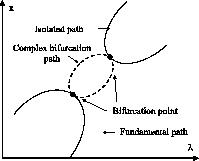
engineering & technology publications
ISSN 1759-3433
PROCEEDINGS OF THE SEVENTH INTERNATIONAL CONFERENCE ON COMPUTATIONAL STRUCTURES TECHNOLOGY
Connection to a Disjointed Path using a Complex Bifurcation Solution
+Fuji Research Institute Corporation, Tokyo, Japan
*Mitsui Knowledge Industry Corporation, Tokyo, Japan
#Department of Mathematical Information Engineering, College of Industrial Technology, Nihon University, Narashino-shi, Japan
Recently, a new bifurcation phenomenon called complex bifurcation has been proposed by Henderson [1], and Henderson & Keller [2]. The basic idea is simply that real solution paths of real analytic problem frequently have complex bifurcating form them. It is known that this phenomenon occurs at limit points, at pichfork bifucation points, and at isola centers. The solution bifurcate corresponding to both the real and imaginary of roots of the algebratic bifurcation equation. This solution path is so-called complex path and connected to disjointed real solution path. Conseqently, the complex path is effective path to find new real solution path.
In this paper, we propose a numerical method to obtain the above complex solutions at a bifurcation point by using arc-length method in conjunction with a bifurcation procedure. To obtain the solutions on real path, we use arc-length method which is known as one of the incremental solution procedure. Especially, it is easy to track the solution beyond limit point. At a singular point, we use Hosono method to obtain the increment complex solutions. The applicability of the method has been already shown in elastic buckling problem [3,4,5]. This method is a powerful method to obtain the increment solution on the singular point as a limit point or a pichfork bifurcation point. Moreover, we need not calculate the second-order increment equation which is used by the static perturbation method , as well as eigen value problem. On the complex path, we track the complex solution by using arc-length method. We apply our method to several fundamental examples to verify the applicability and eãctiveness of the method. In numerical results, we show the results that the complex path connect to a disjointed real path by using our method.
- 1
- M.E. Henderson, Complex Bifurcation, PhD Thesis, California Institute of Technology, (1985).
- 2
- M.E. Henderson, H.B. Keller, Complex Bifurcation from Real Paths, J. Appl. Math., 50(2), (1990), 460-482. doi:10.1137/0150027
- 3
- T. Hosono, Analysis of Elastic Buckling Problem by Arc Length Method (Part 1 The Nature of Incremental Solution at the Buckling Point), Transc. of the Architectural Institute of Japan, 242, (1976), 41-50.
- 4
- T. Hosono, Analysis of Elastic Buckling Problem by Arc Length Method (Part 2 The Arc Length Method for Actual Numerical Analysis ), Transc. of the Architectural Institute of Japan, 243, (1976), 21-31.
- 5
- T. Manabe, N. Tosaka and T. Honma, Bifurcation Analysis of an inexetensible elastic ring by integral equation method, Transc. of Japan SIAM, 8, (1998), 67-79.
- 6
- Kubícek, M. and Marek, M., Computational Methods in Bifurcation Theory and Dissipative Structures, Springer - Verlag, (1983)
purchase the full-text of this paper (price £20)
go to the previous paper
go to the next paper
return to the table of contents
return to the book description
purchase this book (price £135 +P&P)
